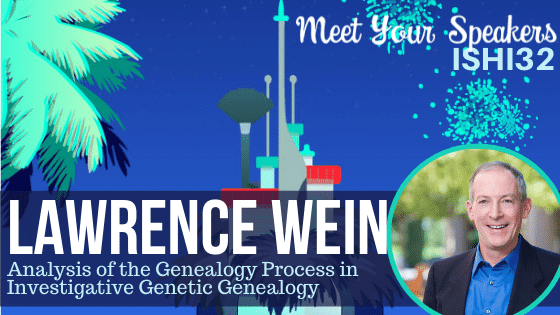The genealogy process is typically the most time-consuming part of – and a limiting factor in the success of – investigative genetic genealogy. In his presentation at ISHI, Lawrence Wein will present a systematic approach to efficiently perform the genealogy portion of investigative genetic genealogy. He and his colleagues have formulated a two-stage mathematical model of the genealogy process: an ascending stage that attempts to find the most recent common ancestors (MRCAs) between the unknown individual and each investigated match, and a descending stage that searches for a marriage among the descendants of the MRCAs.
We chatted with Larry to discuss how his approach will simplify the genealogy process, any training needed, and how members of the public can access their software.
Can you explain the current process(es) that are used in genealogy? How long might these processes take?
It is a two-stage process. In the ascending stage, you look for the Most Recent Common Ancestors (MRCAs) between the unknown individual (e.g., criminal suspect or unidentified remains) and a match (e.g., from GEDmatch or FTDNA). In the descending stage, you look for an intersecting marriage between descendants of the MRCAs found in the ascending stage. There is a wide range of outcomes: easy cases, where close matches are available, may be solved in hours, and difficult cases may go unsolved after many months of work.
Without giving too much away, how does your approach simplify the genealogy process?
By building a detailed mathematical model of the process and estimating the parameters of this model using 17 cases from the DNA Doe Project, we can do two things. First is performance analysis: Given the list of matches (and genetic distances to the unknown individual), we can estimate the probability of solving the case and the amount of work that is required. Second is optimization: if I am in the middle of an investigation, what should I do next? Should I investigate someone from the list of matches, and if so, which one? Or should I descend from a possible MRCA, and if so, which one?
What kind of training or tools are needed for using your mathematical approach? Would this process be something that forensic laboratories could bring in-house, or do they require an expert?
The two main tools are probability theory and stochastic dynamic programming. The latter tool is a framework for making optimal decisions over time and under uncertainty. In the FGG context, the “state of the system” evolves over time as you build the family tree, and the uncertainty stems from the fact that you cannot always identify matches, or people’s parents or children. Once we complete our study, we hope to make our software available to the public for free. As with the use of any algorithm, the more you understand about it, the better. But we hope to get the software to a stage where it could be brought in-house.
What tips would you give to someone who is just starting out in the field of forensics, or what is the best advice that you’ve received?
While in graduate school at Stanford, the late Sam Karlin told me: To be a good applied mathematician, you need to know ten times as much math as you are going to use.
Has there been anything good that came out of the pandemic that you’ll continue doing going forward?
I am a Senior Associate Dean who oversees 130 Ph.D. students at Stanford. During the pandemic, my staff aggressively engaged with these students in an effort to maintain good mental health. We will continue this practice as we emerge from the pandemic.
What is your favorite Disney character and why, or which Disney character do you most relate to and why?
I have a pet California rabbit (white with red eyes) who lives in my living room and has been a good companion during the pandemic. So I guess I would choose White Rabbit from Alice in Wonderland (it is also a great song).
What’s one thing that others may not know about you?
I don’t think anyone in this community knows me or anything about me – I don’t know anyone aside from my two amazing co-authors. I am not a forensic scientist. I am an applied mathematician, and in the years after the September 11, 2001 attack, my research on avoiding or mitigating catastrophic events was implemented nationwide on a number of issues (nuclear, smallpox, anthrax, botulinum toxin, US-VISIT Program, pandemics). In the last few years, I have become interested in crime solving via ballistic imaging, sexual assault kits and FGG.
WOULD YOU LIKE TO SEE MORE ARTICLES LIKE THIS? SUBSCRIBE TO THE ISHI BLOG BELOW!
SUBSCRIBE NOW!


